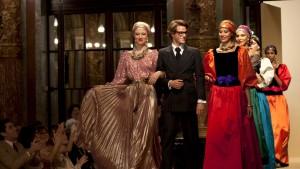-

CAROLE BETHUEL/SONY PICTURES CLASSIC ★★★★☆
In Bertrand Bonello’s “Saint Laurent,” to be released May 8, the formulaic biopic is decomposed and reconstructed to parallel the French designer’s innovative fashion. Time becomes meaningless as Yves Saint Laurent’s muses, business ventures and lovers are woven into a holistic view of his career. While YSL is applauded today for redefining the female figure, Bonello paints a chilling image of YSL, placing his narcissism and hedonism at the forefront of the movie. In fact, the male-dominated cast challenges YSL’s legacy as the demolisher of gender barriers in fashion.
In the opening scene, the viewer is violently thrust into a dreary hotel room where YSL offers a gritty account of his traumatic experience during the Algerian War. According to Bonello, this surprising chronological choice is meant “to enter directly within the character’s fragility and his faults.” Bonello uses a similar lack of reverence throughout the movie as muses, lovers and business partners are thrown into YSL’s life without any context for the viewer.
This film jumps directly into the peak of YSL’s career, with particular emphasis on the years 1967 and 1976. Hypnotic nightclubs are juxtaposed with the calculated austerity of YSL’s labs as chaos and order alike shape his collections. Leading actor Gaspard Ulliel balances his own fragile sensuality with calculated vitality to perfectly capture YSL’s contradictions. YSL’s genius is reinforced by the vigor of Pierre Berge (Jeremie Renier) and Jacques de Bascher (Louis Garrel), his long-time lovers. The intoxicating Jacques, a Chanel model and Karl Lagerfeld’s lover, feeds YSL’s drug and sex addiction that Pierre — YSL’s business partner — directs into brand development. The men represent the backbone of both YSL and of the film itself, where time, trends and personalities seem as fickle as YSL’s Black Opium perfume.
As pills and lovers multiply, the audience reaches the 150-minute finish line in a tobacco-filled stupor. Bonello’s choice of scenes seems almost arbitrary as YSL’s psychological complexity grows with every passing minute, putting into question the director’s desired effect. YSL’s designs seem to become a second thought as his orgies are depicted with clinical precision, defying the film’s generous R rating. A viewer hoping for a holistic image of YSL’s career will be sourly disappointed as his collections hardly feature in the film. In fact, YSL’s Le Smoking collection, which revolutionized the fashion industry by dressing women in tuxedos, was merely suggested in a short recreation of Helmut Newton’s iconic photograph for the collection. Costume designer Anaïs Romand also suffered from Bonello’s approach, her brilliant designs receiving little screen time in the face of Bonello’s repeated adult scenes.
Although uncomfortable and frustrating, Bonello’s brilliant tactic forces the viewer to experience the decomposition of a beautiful mind that resulted in the tortured genius of YSL we know today. While the audience remains crippled by the death of YSL’s French bulldog Moujik throughout the film, YSL’s death seems a simple afterthought. As such, “Saint Laurent” is a film not about a designer, not about a man and not about a lover. During a photo-shoot, a nude model sighs, “Where is Saint Laurent now? I do not know. Maybe he is just a perfume.” Indeed, Bonello’s “Saint Laurent” will elucidate nothing about YSL’s life but will reveal the entirety of his essence. The audience delves into the character through the concoction of the era’s art, films, pills, Warhol paintings, cigarette butts, Proust quotes and Marrakech silks that make up the ephemeral YSL, leaving dialogue and fashion as insignificant supplements. The film concludes with YSL’s chef d’oeuvre, the 1976 Opera Ballet Russe Collection, in which Bonello manipulates his operatic score and Mondrianic split-screen montages to morph the viewer into YSL at the peak of his career.
Capturing the essence of YSL being may have been more difficult than anticipated as Bonello’s film rivaled Jalil Lespert’s biopic “Yves Saint Laurent” released a few months earlier. While both movies study the same protagonist, they could not be more different in style. Bonello sought to reconstruct the causes of YSL’s creative drive, while Lespert presented a traditional narrative of the designer’s life. In addition, Bonello’s dark take on the designer resulted in a backlash from the label, which repeatedly delegitimized the film in public. Bonello’s risks certainly paid off as the film received critical acclaim at the Cannes Film Festival and has already been sent by France to the Academy for Best Foreign Film. This film is certainly unparalleled in style and cinematography, as best explained by YSL himself. Straightening his leopard bowtie, he smirks: “There is no competition — that is my misfortune.” Uncomfortably taxing yet simply brilliant, this film perfectly encapsulates YSL — unparalleled in every sense of the word.














